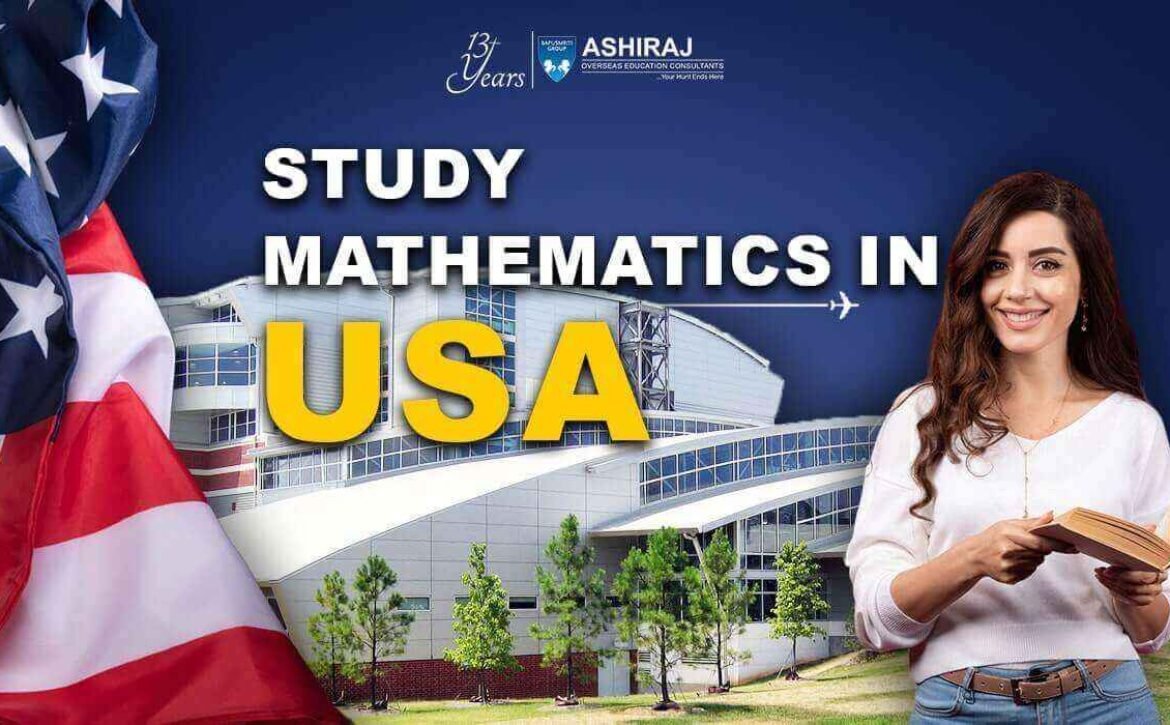
Mathematics in USA
Mathematics in the USA holds a pivotal role in shaping various sectors, from technology and finance to education and research. The nation boasts a rich history of mathematical achievements and contributions, with prominent figures like Benjamin Banneker, John von Neumann, and Katherine Johnson making indelible marks. With renowned institutions such as MIT, Harvard, and Stanford leading the forefront of mathematical research and education, the United States remains a powerhouse in the global mathematical community. From foundational concepts like calculus to cutting-edge fields such as cryptography and data science, American mathematicians continually push the boundaries of knowledge and innovation.
In academia, government, and industry alike, the demand for skilled mathematicians in the USA continues to grow. Whether it’s designing algorithms for artificial intelligence, analyzing complex financial markets, or tackling pressing societal challenges, the application of mathematics permeates every facet of American society. As the digital age accelerates and interdisciplinary collaboration becomes increasingly essential, the significance of mathematics in the USA only intensifies, underscoring its vital role in driving progress and shaping the future.
Why to Study Mathematics in the USA?
- Diverse Opportunities: The United States offers a wide range of academic programs and research opportunities in mathematics, catering to diverse interests and career paths.
- World-Class Institutions: Renowned universities such as MIT, Harvard, and Stanford are at the forefront of mathematical research and education, providing access to top-notch faculty and resources.
- Cutting-Edge Curriculum: Mathematics programs in the USA are known for their innovative and comprehensive curriculum, covering foundational concepts as well as emerging fields like cryptography and data science.
- Interdisciplinary Collaboration: The interdisciplinary nature of mathematics education in the USA allows students to collaborate with experts from various fields, enhancing their problem-solving skills and fostering creativity.
- Career Prospects: Graduates with a mathematics degree from the USA are highly sought after in industries ranging from technology and finance to healthcare and engineering, opening doors to lucrative and fulfilling career opportunities.
- Global Recognition: A mathematics degree from a prestigious American institution carries significant weight internationally, providing graduates with a competitive edge in the global job market.
- Networking Opportunities: Studying mathematics in the USA allows students to connect with professionals, researchers, and peers from around the world, building valuable networks for future career advancement.
- Personal Growth: Beyond academic and professional benefits, studying mathematics in the USA offers opportunities for personal growth, critical thinking, and intellectual exploration.
In conclusion, pursuing mathematics education in the USA offers unparalleled advantages, making it an excellent choice for aspiring mathematicians and professionals seeking to excel in this dynamic field.
Top Universities to Study Mathematics in USA
University | QS World University Rankings 2023 | Type of University | Average Annual Fees | Programs Offered |
Massachusetts Institute of Technology (MIT) | 1 | Public | $53,790 | Mathematics, Applied Mathematics, Statistics |
Harvard University | 3 | Private | $51,925 | Mathematics, Applied Mathematics, Statistics, Mathematical Biology |
Stanford University | 5 | Private | $56,169 | Mathematics, Applied Mathematics, Statistics, Computational Mathematics |
California Institute of Technology (Caltech) | 6 | Private | $56,862 | Mathematics, Applied Mathematics, Statistics, Mathematical Physics |
Princeton University | 7 | Private | $53,770 | Mathematics, Applied Mathematics, Statistics |
Mathematics in the USA thrives within the academic landscapes of these prestigious institutions, which are renowned globally for their excellence in mathematical research and education. These universities consistently rank among the top in the QS World University Rankings, offering diverse programs in mathematics and related fields. While the average annual fees vary across these institutions, students can expect unparalleled opportunities for intellectual growth and career advancement. Whether pursuing pure mathematics, applied mathematics, statistics, or interdisciplinary studies, students enrolled in these universities benefit from access to world-class faculty, cutting-edge resources, and a vibrant academic community. Aspiring mathematicians seeking quality education and research opportunities would find these universities to be ideal destinations for fulfilling their academic and professional ambitions.
Course Curriculum for Mathematics in USA
- Foundational Courses: Mathematics programs in the USA typically start with foundational courses covering topics such as calculus, linear algebra, and discrete mathematics.
- Advanced Topics: As students progress, they delve into advanced topics including real analysis, abstract algebra, differential equations, and complex analysis.
- Specialized Tracks: Many universities offer specialized tracks or concentrations within the mathematics major, such as applied mathematics, statistics, computational mathematics, or mathematical biology.
- Interdisciplinary Integration: Mathematics programs often integrate interdisciplinary courses, allowing students to apply mathematical principles to fields such as computer science, physics, finance, and biology.
- Research Opportunities: Students are encouraged to engage in research projects under the guidance of faculty members, providing hands-on experience and opportunities for publication.
- Electives and Seminars: Elective courses and seminars allow students to explore specific areas of interest within mathematics, further customizing their educational experience.
- Capstone Projects: Many programs culminate in a capstone project or thesis, where students apply their knowledge and skills to solve real-world problems or contribute to ongoing research.
- Industry Relevance: The curriculum is designed to equip graduates with the analytical, problem-solving, and critical-thinking skills sought after by industries such as technology, finance, healthcare, and engineering.
Mathematics in the USA encompasses a comprehensive curriculum that prepares students for a wide range of career paths and academic pursuits, fostering a deep understanding of mathematical principles and their applications in various fields.
Eligibility Criteria & Admission Requirements for MS in Mathematics in USA
- Academic Qualifications:
Bachelor’s degree in mathematics or a related field from a recognized institution.
Strong academic background with coursework in calculus, algebra, and advanced mathematics.
- Standardized Test Scores:
IELTS or TOEFL: Minimum scores vary by institution but generally range from 6.5 to 7.5 for IELTS and 80 to 100 for TOEFL.
GRE or GMAT: GRE scores typically range from 155 to 165 for the quantitative section, while GMAT scores range from 650 to 750.
- Application Materials:
Passport & Student Visa: Valid passport and appropriate student visa for studying in the USA.
Academic Certificates: Transcripts from previous educational institutions demonstrating academic achievement.
Work Experience: Some programs may require or prefer applicants to have relevant work experience in mathematics or a related field.
- Letters of Recommendation:
Typically, two to three letters of recommendation from professors or professionals familiar with the applicant’s academic and/or professional abilities.
- Statement of Purpose:
A well-written statement outlining the applicant’s academic background, research interests, career goals, and reasons for pursuing graduate studies in mathematics in the USA.
- Interview (if required):
Some programs may require applicants to participate in an interview to assess their suitability for the program.
- Additional Requirements:
Some programs may have additional requirements, such as a writing sample or a preliminary exam in mathematics.
Mathematics in the USA offers rigorous academic programs with specific eligibility criteria designed to ensure that incoming students have the necessary skills and preparation to succeed in their studies.
Documents Required for Studying Mathematics in USA
- Passport: Valid passport for international travel and study in the USA.
- Letters of Recommendation (LOR):
Typically, two letters of recommendation from professors or professionals familiar with the applicant’s academic abilities and potential for success in mathematics programs.
- Statement of Purpose (SOP):
A well-written statement outlining the applicant’s academic background, research interests, career goals, and reasons for pursuing mathematics studies in the USA.
- Curriculum Vitae (CV):
A comprehensive resume highlighting academic achievements, relevant coursework, research experience, publications (if any), and extracurricular activities.
- Official High School Transcripts:
Transcripts from the applicant’s high school or secondary education institution, demonstrating academic performance and completion of required coursework.
- Educational Certificates:
Copies of certificates or diplomas earned from previous educational institutions, including any degrees or qualifications obtained.
- Work Experience Certificate:
If applicable, a certificate verifying any relevant work experience in mathematics or related fields.
- Proof of Financial Resources:
Documentation demonstrating the applicant’s ability to finance their education and living expenses while studying in the USA, such as bank statements, scholarship awards, or sponsorship letters.
Mathematics in the USA requires a thorough documentation process to ensure that applicants meet the necessary academic, financial, and personal requirements for studying in American institutions.
Admission Process for Mathematics in USA
- Research Programs: Begin by researching mathematics programs offered by universities in the USA, considering factors such as faculty expertise, research opportunities, and program curriculum.
- Review Eligibility Criteria: Check the admission requirements for each program, including academic qualifications, standardized test scores (such as GRE or GMAT), English proficiency (IELTS or TOEFL), and required documents.
- Prepare Application Materials: Gather required documents, including transcripts, letters of recommendation, statement of purpose (SOP), curriculum vitae (CV), and proof of financial resources.
- Take Standardized Tests: Take the necessary standardized tests, such as GRE or GMAT for academic aptitude and IELTS or TOEFL for English proficiency. Prepare thoroughly and aim for competitive scores.
- Submit Applications: Complete online applications for selected mathematics programs, ensuring all required documents and fees are submitted before the deadlines.
- Monitor Application Status: Regularly check the application portals or contact the admissions office to track the status of your applications and ensure all materials have been received.
- Prepare for Interviews (if required): Some programs may require interviews as part of the admissions process. Prepare by researching the program and practicing common interview questions.
- Receive Admission Offers: Await admission decisions from universities. Upon receiving offers, carefully review the terms, deadlines, and any funding opportunities provided.
- Accept Offer and Prepare for Visa: Once a decision is made, accept the offer from the preferred university and begin preparations for obtaining a student visa, including completing required forms and attending visa interviews.
- Finalize Enrollment: Complete any additional requirements, such as submitting health records or attending orientation sessions, to finalize enrollment and begin your journey studying mathematics in the USA.
Mathematics in the USA involves a systematic approach to the admission process, requiring thorough preparation, attention to deadlines, and effective communication with universities.
“Education is the most powerful weapon which you can use to change the world.”
Nelson Mandela
Cost of Mathematics Course in USA
- Tuition Fees: The cost of tuition for mathematics programs in the USA varies depending on the institution, program level, and residency status. On average, annual tuition for undergraduate programs ranges from $20,000 to $50,000, while graduate programs can cost $30,000 to $60,000 per year.
- Living Expenses: In addition to tuition, students must budget for living expenses, including accommodation, meals, transportation, and personal expenses. Living costs vary widely depending on the location and lifestyle, ranging from $10,000 to $20,000 per year.
- Books and Supplies: Mathematics students may incur additional expenses for textbooks, course materials, and laboratory supplies. Budgeting for books and supplies can add several hundred to a few thousand dollars per year to the overall cost.
- Health Insurance: International students studying in the USA are typically required to have health insurance coverage. The cost of health insurance varies by provider and coverage options, ranging from $1,000 to $3,000 per year.
- Miscellaneous Fees: Some universities charge miscellaneous fees for services such as student activities, technology access, and campus facilities. These fees can vary but typically range from a few hundred to a few thousand dollars per year.
Overall, the cost of studying mathematics in the USA can range from $30,000 to $80,000 or more per year, depending on various factors such as the institution, location, program level, and individual lifestyle choices. Mathematics in the USA offers world-class education and research opportunities, but it’s essential for prospective students to carefully consider and plan for the associated costs.
Scholarships for Mathematics Courses in USA
Scholarship Name | Amount | Application Deadline |
Fulbright Scholarship | $20,000 – $45,000 | October 11 |
NSF Graduate Research Fellowship | $34,000 stipend + $12,000 for tuition | October 25 (varies by discipline) |
AMS Graduate Fellowships | $10,000 – $15,000 | February 6 |
SIAM Student Travel Awards | $500 – $1,500 | Varies (conference-specific) |
NSA Mathematics Student Scholarship | $500 – $2,000 | March 31 |
Scholarships for Mathematics in the USA offer financial support to deserving students pursuing undergraduate or graduate studies in mathematics-related fields. These scholarships vary in amount and eligibility criteria, providing opportunities for students to offset tuition costs, fund research endeavors, or attend conferences. The application deadlines for these scholarships typically fall between October and March, with some variations depending on the scholarship provider. Mathematics in the USA thrives with the support of such scholarships, which recognize and encourage academic excellence and innovation in the field. Prospective students are encouraged to explore these scholarship opportunities and apply before the respective deadlines to enhance their educational experience and alleviate financial burdens.
Career Opportunities After Mathematics in USA
Job Profile | Average Salary (per year) |
Data Analyst | $65,000 – $95,000 |
Actuary | $85,000 – $120,000 |
Operations Research Analyst | $80,000 – $110,000 |
Financial Analyst | $70,000 – $100,000 |
Statistician | $80,000 – $110,000 |
Career Opportunities After Mathematics in the USA offers lucrative prospects for graduates with strong analytical and problem-solving skills. Data analysts utilize mathematical techniques to analyze large datasets and derive insights for decision-making processes, earning an average salary ranging from $65,000 to $95,000 per year. Actuaries assess financial risks and design strategies to minimize losses, commanding salaries between $85,000 and $120,000 annually. Operations research analysts apply mathematical models to optimize processes and resource allocation, earning salaries in the range of $80,000 to $110,000 per year. Financial analysts analyze market trends and investment opportunities, earning average salaries between $70,000 and $100,000 annually. Statisticians utilize statistical methods to analyze data and interpret results, earning salaries ranging from $80,000 to $110,000 per year. Mathematics in the USA opens doors to diverse and rewarding career paths, where professionals contribute to various industries while enjoying competitive salaries and opportunities for growth.
Frequently Asked Questions About Mathematics in USA
Some of the top universities for studying mathematics in the USA include the Massachusetts Institute of Technology (MIT), Harvard University, Stanford University, California Institute of Technology (Caltech), and Princeton University.
Depending on the institution, applicants may need to take standardized tests such as the GRE (Graduate Record Examination) or the GMAT (Graduate Management Admission Test) for graduate programs, and the IELTS or TOEFL for English proficiency.
Mathematics graduates in the USA can pursue careers as data analysts, actuaries, operations research analysts, financial analysts, statisticians, and more, with competitive salaries and opportunities for advancement.
Yes, there are various scholarships available for mathematics students in the USA, including the Fulbright Scholarship, NSF Graduate Research Fellowship, AMS Graduate Fellowships, SIAM Student Travel Awards, and NSA Mathematics Student Scholarship.
The cost of studying mathematics in the USA varies depending on factors such as tuition fees, living expenses, books and supplies, health insurance, and miscellaneous fees, ranging from $30,000 to $80,000 or more per year.
Required documents for admission to mathematics programs in the USA typically include academic transcripts, standardized test scores, letters of recommendation, a statement of purpose, curriculum vitae, and proof of financial resources.
International students studying mathematics in the USA may be eligible for on-campus employment opportunities, internships, or Optional Practical Training (OPT) programs, subject to certain restrictions and regulations.
The application process for mathematics programs in the USA typically involves researching programs, meeting eligibility criteria, preparing application materials, taking standardized tests, submitting applications, and awaiting admission decisions.
Yes, there are ample research opportunities for mathematics students in the USA, both within academic institutions and through collaborations with industry partners, research centers, and government agencies.
To prepare for studying mathematics in the USA, prospective students can focus on building a strong mathematical foundation, improving their English language skills, gaining research experience, and exploring internship or volunteer opportunities in related fields.




